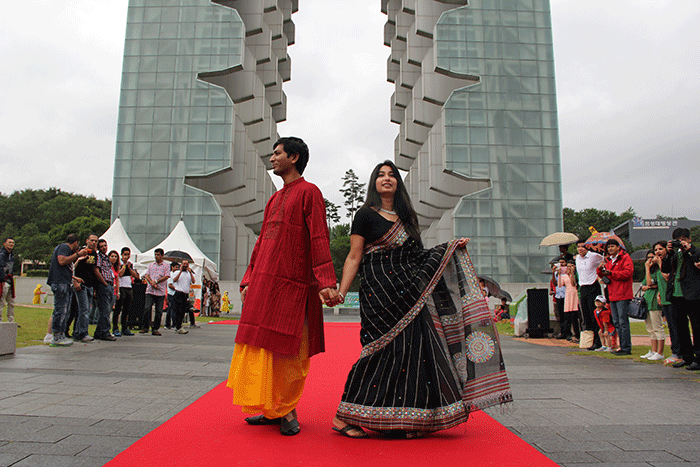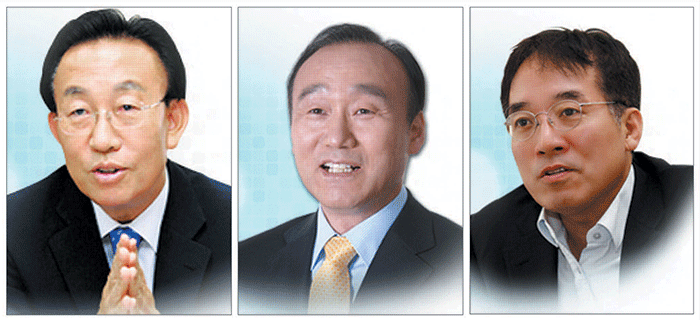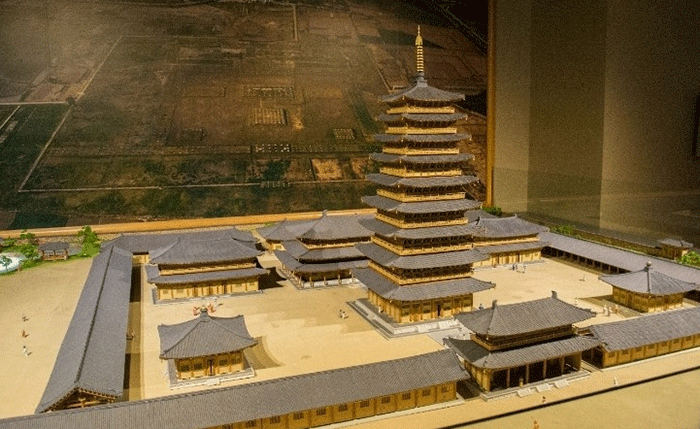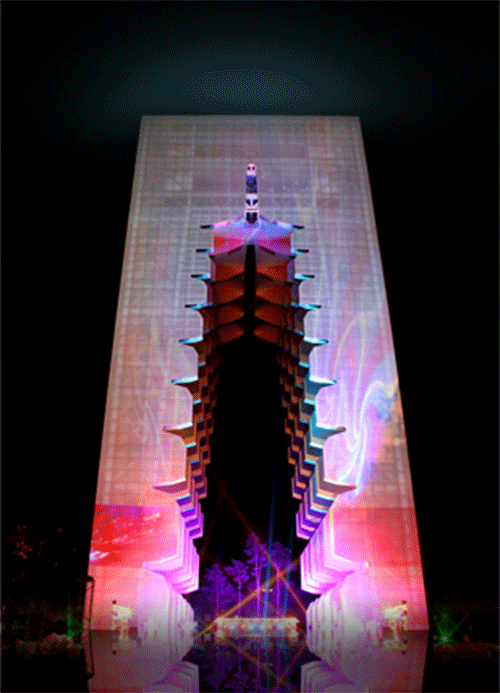On May 29-31, 2015
The Gyeongsangbuk-do Province and the Gyeongju City are hosting the International Student Festival of the 2nd Gyeongju Silk Road Culture Expo on May 29-31, 2015 in a three-day run with the participation of 1,000 international students in Korea from 40 different countries of the world. The festival takes place for the successful hosting of the 2015 Gyeongju Silk Road Culture Expo as well as for the promotion of friendship among the different culture of the world. In the process of association among the students of these countries, a social network is expected to be formed for the spread of information on the Expo.

Included in the programs of the International Student Festival are an international fashion show, international booth exhibitions, food festival, singing, opera and story-telling.
The organizers are also preparing an awarding system for the outstanding exhibition booth and excellent fashions, including Lee Young-hee Hanbok.
Ambassadors and madams are invited to attend the opening ceremony of the International Student Festival on May 30-31, 2015.
Gyeongju World Culture Expo on Aug. 21-Oct. 18, 2015 (피플헤더)
The governments of the Gyeongsangbuk-do Province and the Gyeongju City co-host the 2015 Gyeongju World Culture Expo at the Gyeongju World Culture Expo Park and throughout the Gyeongju City on Aug. 21-Oct. 18, 2015 in a 59-day run. It is held on the theme of ‘Eurasia Culture Express Train’ and for the facilitation of implementation of the Eurasia Initiative of the Central Government through promotion of culture, promotion of cultural exchange among the Silk Road countries and enhancement of harmony and cultural exchange among the involved countries.

Advanced cultural contents will be developed through the use of the experience and expertise gained in the process of hosting cultural festivals for the past 15 years
Efforts will also be made to develop the Expo in such a way that it will lead to firmly building a bridgehead to expand Korea’s forays into the Middle East and Europe.
Attempts will also be made to create an excellent Korean brand of the Silk Road continuously enhancing the popularity of Hallyu (Korean Image) through harmonious merger of the traditional Korean culture and arts, especially those of the Silla Dynasty (57BC-AD935), with modernity and through convergence of analogue sensitivity with digital technology.
According to the organizers, they develop a new civilization with cutting-edge information-communication technology.
The Gyeongju City is an excellent evidence of the flourishing Buddhist culture of the Silla Dynasty. In particular, the Seokguram Grotto is a cavern Buddhist temple constructed in the height of the brilliant Buddhist culture of the era and is rated as a world-class work of art noted for its beautiful balance and harmony.

The Seokguram Grotto will greet the visitors with a new appearance during the 2015 Gyeongju Silk Road Expo that will be held in the Gyeongju City in August this year.
The noted cavern temple will be reborn in new images through the use of information-communication technology, including HMD (head mounted display) and 3D images, which will provide the visitors with a new experience. The visitors will feel as if they were virtually moving into the interior of the Seokguram Grotto itself. Furthermore, the visitors can also actually experience a sensation of actually touching things with their own hands.
In addition, there is the story-telling exhibition technique to be utilized, which the visitors will find both interesting and instructive.
There will also be a multi-media show in which images of the famed 9-story Wooden Pagoda of the Great Hwangnyong-sa Buddhist Temple together with the famous 9-story giant Wooden Pagoda will be projected on the walls of the Gyeongju Tower and the Tower of the Dongkuk Steel.
Also included in the plan is the ‘Drone Show’ in which drone-carried cameras will cover various activities and events of the Gyeongju Silk Road Expo and broadcast the images to the audience through TVs.
Thus the 2015 Gyeongju Silk Road Expo will provide the visitors and audiences of the world with excitement, fun and education transcending the space and time.

(The mammoth Hwangyong-sa Buddhist Temple of the Silla Dynasty was built on a land lot of 25,000 pyeong [82.645 square kilometers] was burnt down and reduced to ashes in the 25th Year of King Gojong of the Goryeo Dynasty (1238) by the invasion army of Mongolia.?Ed.)
Governor Kim Kwan-yong of Gyeongsangbuk-do Province:
A long time ago, a great journey of mankind took place along the path of civilization?the Silk Road!
The Silk Road, after a long sleep in the history, is now waking up. In the upcoming August this year, a grand cultural festival takes place in the ancient capital of the Silla Dynasty with a history of 1,000 years one the theme of Silk Road.
The 2015 Gyeongju Silk Road Expo prove a grand festival of diverse cultures participated by all the different countries along the Silk Road on land and sea, which will be enjoyed by all the peoples through dialogue, communication and fusion.
The might of the culture of the Gyeongju Silk Road Expo will tow the Creative Economy of the Republic of Korea and help realize our dream for the cultural rejuvenation and co-prosperity of mankind.
The Gyeongsangbuk-do Province wishes to become a true partner in leading the Era of the New Silk Road of the 21st Century and aspires to build a New Silk Road of Culture and Economy transcending the differences in race, state, religion and culture.
It is a Eurasia Culture Express Train where we embrace the world and will assure a bright future together. I warmly welcome you all to the Gyeongju Silk Road Grand Expo. Eoso Oiso (Welcome)!
Mayor Choi Yang-sik of Gyeongju City:
The Silk Road starts from the beautiful‘Golden City of Gyeongju.’ I am Mayor Choi Yang-sik of Gyeongju City.
The Gyeongsanbuk-do Province and the Gyeongju City jointly host the Korea Silk Road Grand Expoas a very important event. The Silk Road is not a simple route of traders and logistic distribution. It is a route that maintained and promoted the life of politics, culture and economy of the countries of the East and West. The Silk Road accepted the different cultures and peoples and thereby developed a new world.
The Kingdom of Silla, with Gyeongju as its capital, was a country situated at the eastern end of the Silk Road with a multi-cultural society and a forward-looking spirit. The horn-shaped Scythian-style golden cup, the Royal Tomb of Goereung, the Tomb of King Hongdeok with warrior guardian stone monuments, glass beads, and glass cups and the golden swords, are all good examples.
The Silla Kingdom was a ‘Golden Country’ that was always open to the foreign cultures and developed a better culture based on such cultures.
Now based on this culture of a thousand years, the Gyeongsangbuk-do Province and the Gyeongju City will open the Grand Expoof ‘Silk Road Gyeongju 2015’ in the upcoming August this year. We will lead the formation of a new paradigm developing a Silla marketing and a New Hallyu Culture by hosting international academic symposiums and presentation of the traditional visual and performing arts of many different countries of the world. The Golden Culture developed from the Altaic region to the east and west will not bear its Golden Fruits in the Gyeongju City. I welcome you all to this grand festival!
Secretary General Lee Dong-woo of the Organizing Committee of the Expo:
In 2013, the Gyeongsangbuk-do Province and the Gyeongju City World Culture Expo opened a Culture Road that will remain long in the history. We showed to the entire world the brilliant culture of the Silla Dynasty through an exhibition in Istanbul in Turkey 12,000 kilometers away from Korea.
And last year, the City of Istanbul reciprocated it with the visit of a large cultural delegation to Gyeongju with noted visual and performing artists?showing the Korean people the essence of the brilliant culture of Istanbul.
The Gyeongju World Culture Expo will now once again open another Culture Road through Silk Road Gyeongju 2015. Varying cultures and arts of more than 40 different countries of the world will come to Gyeongju through the Silk Road via routes of the plain, sandy desert and seas. The Expo will bind all these Eurasian countries into one along the newly built Culture Silk Road.
The Republic of Korea has a history of five millennia and the Gyeongju City has the cultural treasure of one millennium. The City of Gyeongju will experience the renaissance of its glorious culture that will perform the role of locomotive to pull the Creative Economy of Korea.
For this purpose, the Silk Road Gyeongju 2015 has prepared various interesting programs that cover the ancienttimes and the present and the old tradition and the cutting-edge technology and art of today.
There are a total of over 30 different programs divided in four separate areas, which include the ‘Meeting of the Civilizations’ (where the visitors and audience can access the different histories and cultures of all the different countries), the ‘Golden State of Silla’ (which shows the brilliantgoldenculture of Silla), ‘Venue of Association’ (where different cultures of the Silk Road countries meet with one another) and various other events related with one another.
I welcome you all to the Eurasia Culture Express Train, Silk Road Gyeongju 2015, where you can enjoy the cultures of the east and west at the same time.
Excerpts from the Wikipedia introduction of the Hwangnyongsa Buddhist Temple of Gyeongju:
Hwangnyongsa, or Hwangnyong Temple (also spelled Hwangryongsa) is the name of a former Buddhist temple in the city of Gyeongju, South Korea. Completed in the 7th century, the enormous 9-story structure was built entirely with wood with interlocking design with no iron nails. It had a standing total height of 80 m (262ft), making it the tallest structure in East Asia and the tallest wooden structure in the world at the time of its construction. It was the center of state-sponsored Buddhism during the Silla and Unified Silla eras which were cultural beacons of Buddhism during its time. Its name means "Golden/Yellow Dragon Temple" or "Emperor/Imperial Dragon Temple." Archaeological excavations and other scientific studies of the temple began in April and continue today.
Hwangnyongsa was built during the Silla period, under the patronage of the Silla royal family, on a plain encircled by mountains near the royal palace compound of Banwolseong (Half-Moon Palace). Construction began in 553 under the reign of King Jinheung, and was not fully completed until 644. King Jinheung originally intended for the temple to be the site of a new palace but when a dragon was seen on the proposed site, a temple was commissioned instead.

Hwangnyongsa was designed to be a place where monks prayed for the welfare of the nation by asking for the divine protection of the Buddha and a means to impress foreign dignitaries.
Following the defeat of Baekje in the 660s, the Baekje architect, Abiji, was commissioned to build a nine-story wooden pagoda at the site. This fact indicates that the Baekje had superior knowledge or wooden architecture. The nine stories supposedly represented the nine nations of East Asia and Silla's future conquest of those states.[2] The pagoda stood until it was burned by Mongolian invasions in 1238. No wooden architecture from the Silla people survives today but the ruins of Hwangnyongsa suggest a Goguryeo influence.
The temple site in a valley within Gyeongju National Park near Toham Mountain and about 150 yards (140 m) from Bunhwangsa Temple, was excavated in 1972, revealing the temple layout and covering 40,000 artifacts.
Buddhism was strongly resisted by the nobles of Silla while the king personally supported the new religion. The king's Grand Secretary, Ichadon, suggested that he forge the king's royal seal and create an order that the people adopt the new religion. When the forgery was discovered by the nobles, Ichadon suggested that he be made the scapegoat, and that through his death the power of Buddha be made manifest. The king agreed to the plan. The nobles were predictably outraged when they discovered Ichadon's forgery and the king ordered his execution. Legend has it that when Ichadon was executed, a series of miracles occurred which proved the power and reality of the Buddhist faith, and the nobles converted to the new state religion. Ichadon's sacrifice was the impetus for the building of Hwangnyongsa Temple.
Another legend concerns the giant golden Buddha statue that the temple possessed. It was cast in the reign of King Jinheung as the temple centerpiece. The legend states that the gold for the statue came from King Ashoka of India.[5] Ashoka had apparently attempted to cast a golden triad but failed. He then put the gold in a boat along with scale models of Bodhisattvas. Each country that received the boat was equally unable to cast the statues, and not until the boat had arrived in Silla could a statue be cast.
Only the massive foundation stones of the temple remain in current times. The original complex took seventeen years to complete.
The main hall was 155 feet (47m) in length and 55 feet (17 m) in width.
The longest outer wall of the temple was 288 meters in length and the area enclosed by the outer walls covered approximately 80,000 square meters.
The temple ruins also contain pedestal stones which were for monumental Buddhist statues. One statue of the Sakyamuni Buddha was five meters tall.[4][6]
The temple was originally arranged in the "three Halls-one Pagoda" style which meant that the pagoda was in the center of the complex and flanked by three main halls on the left, right, and behind the central pagoda.
The famous nine-story pagoda, which was commissioned by Queen Seondeok after the main temple was finished, was the largest Korean pagoda ever built as well as being the tallest structure in East Asia and the tallest wooden structure in the world at the time of its completion. It was reported to be 263 feet (80 m) tall and the body was made entirely of wood. Only its foundation stones remain today but they attest to the mammoth proportions of the original structure. The pagoda had a foundation area of 6,084 square feet (565.2 m2), was supported by eight pillars on each side, and had sixty foundation stones.

